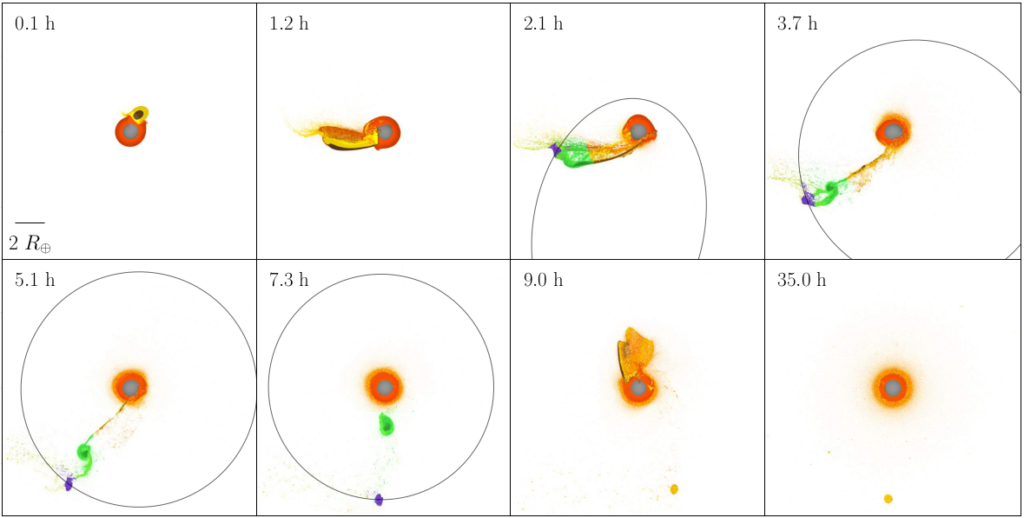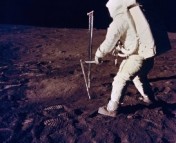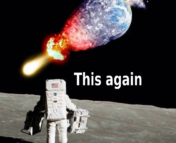Title: Immediate Origin of the Moon as a post-impact Satellite
Authors: J.A. Kegerreis, S. Ruiz-Bonilla, V. R. Eke, R. J. Massey, T. D. Sandnes, L. F. A. Teodoro
First Author’s Institution: Physics Department, Institute for Computational Cosmology, Durham University, Durham, DH1 3LE, UK
Status: Available in the Astrophysical Journal letters [open access], available on the arXiv
No worries, the Moon is not crashing into the Earth in the near future (quite the opposite, really). Also, nothing too big is crashing into the Moon anytime soon, people are looking into it. Rather, the Giant Impact refers to the collision that formed Earth’s close companion some 4.5 billion years ago. The first meet-up of the Earth-Moon couple (Mearth?) started shortly after Earth got devastated – in the literal sense – by another planet called Theia, which is long out of the picture by now (or is it?). The common picture here is that the collision with Theia threw a lot of material around that started circling the young Earth, forming a (temporary) ring. This material then started colliding and forming larger and larger bodies that in the end formed the Moon. Aside from other Moon formation theories, the idea that the Moon was formed by pieces of debris slamming into each other in Earth’s post-Theia ring is now also challenged.
Challenged? Challenged how?
Well, although the “ring of Theia debris” scenario gets many things right, it does have some trouble getting two key points right simultaneously:
- Composition: The Earth’s and the Moon’s mantles are surprisingly similar in composition. With the debris-ring scenario, the Moon would for the majority be made of Theia-material
- Angular momentum: The Earth-Moon systems must always conserve angular momentum (the Moon is moving away, but also the Earth is turning slower at the same time). If the current angular momentum is different from what Moon formation simulations tell us, something is off.
In order to solve this fully, some unlikely Theia-Earth collision should have happened in order to arrive at the composition and angular momentum we observe today. If the Moon formed from a ring of Theia debris, then the parameters of the collision, and the composition of Theia, need to be very finely tuned in order to arrive at the composition and angular momentum we see today. This is very unlikely, so the authors of today’s paper were looking for other, more probable, theories.
The authors propose the scenario where the Moon formed almost directly after the Theia impact, instead of being formed in the ring of debris after some time. Although this scenario was long thought to be unlikely, the paper points in the opposite direction.
Astronomer’s target practice (safety glasses on)
This is where the fun begins for this type of studies: since testing out the real deal is not really an option (creating less than favorable conditions for life on Earth and such), computer simulations are run where a Theia-sized object –the impactor– collides with another Earth-sized body – aptly called the target. These simulations run Smoothed Particle Hydrodynamics (SPH) simulations. In this study, around 100 million particles were simulated. The size of each ‘particle’ is about 14 km, making it quite a bit larger than the asteroid that wiped out the dinosaurs. This is actually pretty small already, considering you need about a million of these particles to arrive at a Moon-sized object and that this is about 100 times more precise than many previous simulations. Several different setups are tested, with different ways to slam the impactor onto the target. The angles of collision (0° being head-on) are changed, varying impactor masses and speeds are used, and also the rotations of both objects are varied.
Running about 400 of these different simulations, it became clear that an angle of 45° on impact gave the best conditions to directly form a large satellite. An example timeline of such a simulation is shown in Figure 1 (see the full animation in 2D and 3D). There, the impactor splinters on the target, throwing a lot of material into orbit. This is where this simulation and previous ones diverge; previous simulations found that most material falls back again and shatters once more into a ring around the target. Here, part of the material stays in orbit, forming a large satellite.

The advantage of these new simulations is that the satellite’s (Moon’s) upper layer composition is much closer to the target’s (Earth’s) composition, consistent with what we see on Earth today. Also, the angular momentum from the simulation matches well with current values.
Now, inherently these simulations are not vastly different from previous versions. So why do they arrive at such a different result? The authors blame the resolution of the simulation: the size of the particles may have been too large in the past or, equivalently, not enough particles were used. By comparing this simulation on the exact same time during the collision but with different amounts of particles, see Figure 2, they show that the particle amount matters. A large satellite does not seem to form with lower particle numbers.

We know that the Moon doesn’t orbit Earth in a perfect circle; in astronomer slang, we say that the Moon’s orbit is eccentric. The paper shows that direct satellite formation with this kind of orbit is perfectly possible when the separate angular momenta are misaligned. In other words, whenever the objects’ rotation axes are tilted with respect to each other in the right way.
Additionally, some simulations resulted in satellites forming with very elliptical orbits, so much so that the closest point of the ellipse falls inside the so-called Roche radius. Inside this radius, a satellite starts to be shredded by the planet since the planet’s gravity is stronger than that of the satellite. The satellites in these simulations can pass the Roche radius but are not necessarily destroyed. They are instead stripped of some material by the planet. Because of this, their orbit widens in order to conserve angular momentum, their orbit now being outside of the Roche radius and the satellite surviving the planet’s Roche radius ordeal in one piece.
The authors show that directly forming a large satellite is not only more likely than previously thought, but can also explain some of the points the debris-ring scenario seems to miss.
Astrobite edited by Isabella Trierweiler
Featured image credit: Le Voyage dans la Lune (A Trip to the Moon), 1902




